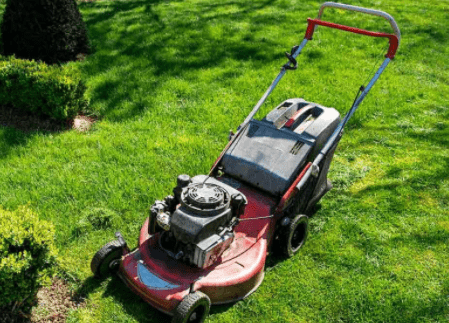
Cooler weather usually take a toll on lawn equipment including mowers and irrigation systems. Cables corrode, debris clog tubes and fuel gets bad. Winterizing your lawn mower for storage is an important maintenance step that will see it running well when the next mowing season comes.
In this handy guide, learn how to winterize a lawn mower before you tuck it away during winter season.
How to Winterize a Lawn Mower – Steps
To prepare your lawn mower for longer winter storage, follow the steps below:
1. Clean the lawn mower deck
A blast of water from a garden hose or a pressure washer will keep blade housing clean throughout the season and most importantly during storage in winter. While this increases mower performance it also helps in preventing moisture, debris and grass clipping from corroding the parts.
Washing off dried dirt and debris might not be enough with a water jet. You may need a plastic paint scrapper or stirrer to scrape off the dirt. Be careful not to hurt yourself with the sharp blades underneath the deck. After cleaning the deck, you might consider sharpening the blades.
2. Drain and stabilize the fuel
Leftover fuel in the tank for a whole winter can wreak havoc on the fuel system. The gasoline is highly likely to degrade and end up causing corrosions and clogs to the engine and carburetor. Draining and filling the tank with fresh stabilized fuel is thus an important step to winterize a mower.
However, the option to drain or stabilize the fuel mainly depends on where you intend to store your mower. Above all, refer to the owner’s manual to find out what the manufacturer recommends for your engine.
Draining the tank
Drain the fuel tank or run it dry if you intend to store the mower in the basement. Fuel is a fire hazard thus not a good idea to store your mower filled with fuel in your basement.
To empty the lawn mower tank, use a siphon or turkey baster and remove as much fuel as you can. Next, run the engine several times until it no longer starts, use the drained fuel elsewhere.
For a push mower, simply tip it over and empty the tank into a drain pan. Look on the carburetor for a bolt or drain valve to drain the gas out of it. Pull the starter rope and let the engine run out until all the gas is consumed.
Stabilizing the fuel
If you plan to store your lawn mower in a garage or shed, fill the tank with fresh gasoline and add a fuel stabilizer. Start and run the engine for a few minutes so that the stabilizer can work its way through the fuel system.
3. Disconnect Power Source
For electric mowers, removing the batteries or disconnect from any power source is a great winterizing step. Check the owner’s manual on how to store the batteries for use during the next mowing season.
To safely remove a battery, start by removing the negative lead, then unplug the positive. With the battery disconnected, you can clean it well, go over the terminals with a wire brush to remove corrosion build-up. When you’re done, store the battery in a cool and dry environment away from flammables and heat sources.
4. Replace spark Plugs
Bad lawn mower spark plugs can also make your lawn mower not to start after the winter storage. To ensure that spark plugs fires well come next season, replace them before stowing the mower for winter. To replace a mower’s spark plugs:
- Disconnect the spark plug lead and clean around the cylinder to ensure that no debris fall in the chamber while removing the plug.
- Use a wrench to remove the spark plug from the cylinder
- Spray a touch of oil to the cylinder and replace the spark plug, gently tightening until it grips.
- Check the spark plug lead for corrosion and clean or replace it if it’s corroded
5. Replace Oil and Air Filters
Filters are important parts that prevent dirt and debris from reaching the engine and carburetor. They should be replaced once every season for optimal performance of your mower. This would be the best time to do the replacement for a better start of next season.
During replacement of oil filters, you should also consider checking and replacing engine oil. Routine engine oil not only improves performance of the mower, it also extends the engine life.
6. Storing the mower
Before you store your mower in the garage or basement, clean dry the engine housing, wheels, handle and any other exposed parts. Keep your mower under a tarp to keep off dust and moisture. Place pet-safe bait stations under the mower to discourage mice from climbing into the mower and chewing up wires.
The Bottom-line
Winterizing a lawn not only give you a head start when the next mowing season comes, it also saves you huge repair and maintenance costs. Without winterizing your lawn equipment, be ready for tough startup in spring when everyone is hands down making their lawns luscious.


